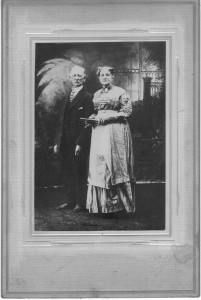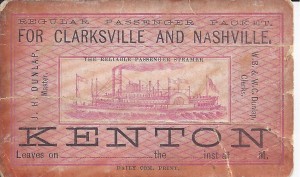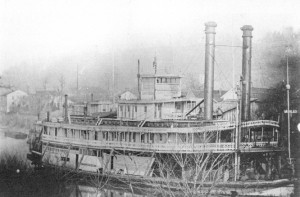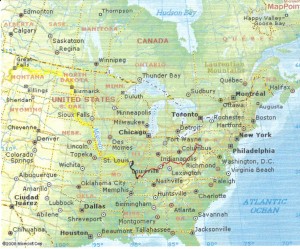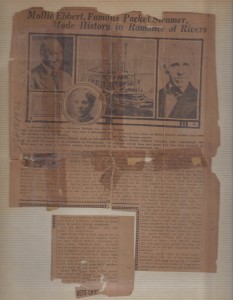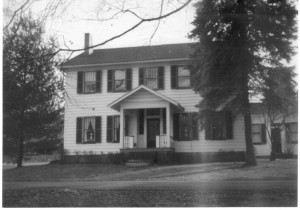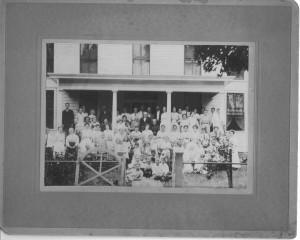Capt George W Ebert
George Washington Ebert, often addressed as Washington Ebert, was born on 3 Aug 1810 near Hagerstown, MD. He died on 24 Apr 1879 in Georgetown, Beaver Co, PA and was interred with his wife Nancy Ann Poe in Georgetown Cemetery. His wife, Nancy Ann Poe, was born in New Lisbon, Columbiana Co, OH on 20 Mar 1818. On 23 Nov 1907 she died in her home in Georgetown, PA. George Washington Ebert was a prominent and wealthy steamboat captain.
He had a long and successful career. During the golden age of packets, he steamed on all the inland rivers and tributaries of the Ohio, Mississippi, and Missouri Rivers. The best way for my great great grandfather to be remembered is to tell his story.
Family Background.
George Washington Ebert was the son of Frederick Ebert and Mary Ann Hague. Little information has been found on Frederick Ebert. Mary Ann Hague was born on 17 Jun 1791 in Hagerstown, MD and died on 9 Oct 1866 in Georgetown, PA. Her second husband was Abraham H Parr.
Capt George W and Nancy Ann Ebert had one daughter, Mary Ann, better known as Mollie Ebert. Mollie was born 17 Sep 1840 in Georgetown, PA and died on 07 Sep 1925.
The steamer Mollie Ebert built and launched in 1869 by Jacob Poe was named for his niece Mollie Ebert Trimble. The steamer was his masterpiece. It cost $35,000 with a capacity of 600 tons. Mollie Ebert Trimble and her Aunt Elizabeth Poe Mathews helped christen the steamer and then went on her maiden voyage to New Orleans. The Mollie Ebert was described in “The Romance of the Rivers”. [1]
Business Ventures.
Bridgewater. The Bridgewater was built in 1843 and Capt George W Ebert was her master. She ran the Pittsburgh to Wheeling trade and was able to run in low water conditions. Her partner boat the was Belmont owned and operated by Capt Jacob Poe.
Hudson. The Hudson was a 94 ton sternwheel built in 1846. in Glasgow, PA for Capt George W Ebert, her first master. In Dec 1848, Ebert sold the vessel to fellow Georgetown resident James McMillan. wo also ran her from Pittsburgh to ports in Ohio. In Apr 1850, the boat was carry CA prospectors from Ohio. They were robbed “and all started home without a cent”.
Glaucus. The sidewheel wooden hull packet named the Glaucus was built in West Elizabeth, PA in 1849 for the St Louis to Keokuk Packet Line. Its capacity was 154 tons. George Washington Ebert was part owner and captain. The Glaucus met a fiery end on 30 Mar 1852 in Montrose, IA.[2]
Washington City. The Washington City, a side wheeler built in Freedom, PA in 1852, worked in the Pittsburgh to Cincinnati trade. Her capacity was rated at 282 tons. In 1855, George Washington Ebert was her master. With mainly a Georgetown crew, he made a special run to St Louis to collect the body of his brother-in-law, Joseph Mc Calhoon, who had died of cholera. The Washington City was off the books in 1859.[3]
Argyle. The sidewheel wooden hull packet named the Argyle was built for Jacob Poe in Freedom, PA in 1853. It was rated at 319 tons – the largest capacity Poe boat to that time. Partners in the venture were Capt George W Ebert and Standish Peppard. Capt Ebert commanded the boat between Cincinnati and New Orleans and St Louis and New Orleans. Standish Peppard was the first clerk. [4]
The Argyle served during the Civil War transporting Gen Grant’s troops on the Tennessee River. She was part of the expedition to Pittsburg Landing in Apr 1862 in support of the battle at Shiloh. Later in Sep 1862 she was utilized by the Army as a temporary gunboat for river security. [5] Whether it was impressed or contracted is unknown.
Kenton. The Kenton was a sternwheel wooden hull packet built in Shousetown, PA in 1860. Its capacity was rated at 215 tons. The boat was built under the direction of Capt Nelson Crooks who was also one of its first owners. In Oct 1861 Capt George W Ebert and Standish Peppard, both from Georgetown, PA, bought the steamer for the Pittsburgh to Cincinnati to Louisville trade. [6] A short time after the purchase, the Kenton was called to service by the US Army Quartermaster.
The steamer Kenton had a long and well documented historic life. Much of the collected information during the Civil War years came from the documents held at the National Archives. To hold documents signed by George W Ebert and Standish Peppard is both amazing and intimidating simultaneously.
Yorktown. The Yorktown was a sternwheel packet built in Freedom, PA in 1864 with a rated capacity of 426 tons. Capt Jacob Poe, the initial owner, brought her out in Oct 1864 for a Pittsburgh to Louisville trip. From the files of the Pittsburgh “Commercial” dated 28 Oct 1864: The new and pretty Yorktown, with Capt Jacob Poe in command, leaves for Louisville Saturday. In Jan 1865, Capt George W Ebert bought control of the packet with Standish Peppard in the office. Her main route was Pittsburgh to Cincinnati with an occasional trip to Nashville.[7] In Mar 1866, Standish Peppard hired as his second clerk a son who had served three years with the Union Army. Unfortunately, the first name was not given to identify which of two sons who served was the second clerk.
In 1867 and again in 1868, the Yorktown steamed to Ft Benton in Montana Territory. In 1867, the Yorktown docked at Ft Benton on 14 Jun with 210 tons of freight and 15 passengers. Like clockwork, the Yorktown docked at Ft Benton on 14 Jun 1868 with 200 tons of cargo and 20 passengers. [8] I assume Jacob Poe was aboard as a pilot during these trips. The Yorktown was off the books in 1869.[9]
Carrie Brooks. The Carrie Brooks was a sternwheeler built in 1866 in Pittsburgh, PA. In 1870, she departed Zanesville, OH with emigrants and their possessions bound for Kansas.[10] Capt Ebert was captain and part owner according to a Poe genealogy report produced by Alexander C McIntosh about 1973. John A Trimble bought control in 1878 for the Pittsburgh to Gallipolis and Pittsburgh to Zanesville trade. Neither route had great success so he sold her to Capt William J Kountz who sold the hull to Sisterville, Wv for a wharf boat.
Mollie Ebert. The Mollie Ebert, a sternwheeler built in Pittsburgh in 1869 according to Capt Frederick Way. In 1869 with a load of freight aboard the steamboat Mollie Ebert, Capt George Washington Ebert left Georgetown landing destined for Fort Benton in the Montana Territory. Nancy Ann (Poe) Ebert accompanied her husband and kept a journal on that river voyage. They were steaming right into Indian Territory a few years before General Custer met a bloody defeat at nearby Little Bighorn.
According to the journal, the Mollie Ebert did not dock in Ft Benton. Her freight was unloaded at Cow Island which is approximately 130 miles down river. On Jun 16, 1869, the freight was carried around a chute and loaded on two other steamboats for the final leg to Ft Benton. Failure to reach Ft Benton was an intense disappointment. Measured in miles the roundtrip distance from Georgetown to Ft Benton totaled 4,000 miles. Measured in days, their trip consumed approximately 90 days. The two segments of the journal cover only 920 miles of the trip over 57 grueling days.
Like so many steamers, the Mollie Ebert met her end in flames at the Pittsburgh Wharf on 25 May 1875.
Family History.
The Ebert House was built on the bluff along the river in the 1845. The property was sold by Jacob Poe to George W Ebert on 16 Jan 1845 as recorded in the office of Deeds for Beaver County Vol 30 Page 512. When Mollie Ebert married John A Trimble in 1858, the home became the residence of both families. The property was transferred from George W Ebert to John A Trimble on 22 Jan 1872 (Office of Deeds Vol 63 Page 658). The property stayed in the Trimble family till purchased by Wendell H Welborn on 27 Apr 1945. Today it is the home of Nicholas and Judy Nash Maravich, great great grandaughter of George W Ebert.
River Philosophy. George Washington Ebert started his career as a steamboat captain in the 1840’s long before the regulation of pilots and steam boilers. The issuance and revocation of pilot’s licenses controlled by the Steamboat-Inspection Service was established by the steamboat act of Aug 30, 1852.  This act was an attempt to curb riverboat racing and reduce the number passenger deaths due to steamboat disasters caused by boiler explosions. Pilots were deemed the princes of the river. Without pilots, a high stack packet was worthless. Not all captains were qualified pilots, and not all pilots aspired to be captains. Even when serving a captain who himself was a qualified pilot, the pilot at the wheel reigned supreme during his allotted watch. Steamboat captains and pilots were high stakes gamblers. High risks, high rewards, peak excitement. The term “fighting pilot” was used to describe a pilot who loved racing. Fast boats attracted more passengers and better rates for cargo. For a fighting pilot, the balance between speed and safety tilted toward speed. To the best of my knowledge, George Washington Ebert never held the horns for any trade route. A boat that held the honor of fastest time on a trade route was awarded a mount of gilded antlers which were strung between the high stacks of the boat. The races were called “runs for the horns”.
This act was an attempt to curb riverboat racing and reduce the number passenger deaths due to steamboat disasters caused by boiler explosions. Pilots were deemed the princes of the river. Without pilots, a high stack packet was worthless. Not all captains were qualified pilots, and not all pilots aspired to be captains. Even when serving a captain who himself was a qualified pilot, the pilot at the wheel reigned supreme during his allotted watch. Steamboat captains and pilots were high stakes gamblers. High risks, high rewards, peak excitement. The term “fighting pilot” was used to describe a pilot who loved racing. Fast boats attracted more passengers and better rates for cargo. For a fighting pilot, the balance between speed and safety tilted toward speed. To the best of my knowledge, George Washington Ebert never held the horns for any trade route. A boat that held the honor of fastest time on a trade route was awarded a mount of gilded antlers which were strung between the high stacks of the boat. The races were called “runs for the horns”.
Personal Wealth. According to 1860 census data, George Washington Ebert was a wealthy man. He was listed sixth among the Georgetown captains. His financial position improved to fourth in 1870. His household also claimed one domestic servant in 1870.
Summary.
It is astounding to think of the accomplishments of George Washington Ebert and these few pioneers. Born within the decade of Abraham Lincoln and Charles Darwin, they were risk takers, doers. My wish is that their story will live always and the memories will never die.
Georgetown Cemetery Markers.

George W Ebert Georgetown Cemetery (F Nash Collection)
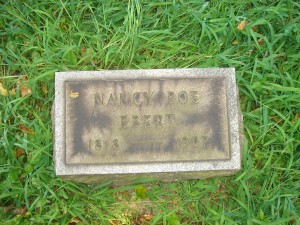
Nancy poe Ebert Georgetown Cemetery (F Nash Collection)
Summary of the George Washington Ebert Steamers
| Packet Name | Build Date Way’s Directory | Original Primary Owner (Signed Cert of Enrollment) |
| Belfast | 1843 | George W Ebert |
| Bridgewater | 1843 | George W Ebert |
| New England | 1844 | George W Ebert |
| Hudson | 1846 | George W Ebert |
| Hibernia* | 1847 | George W Ebert |
| Glaucus | 1849 | George W Ebert |
| Washington City | 1852 | George W Ebert |
| Yorktown | 1853 | George W Ebert |
| Clifton | 1855 | George W Ebert |
| Belmont | 1856 | George W Ebert |
| Melnotte | 1856 | George W Ebert |
| Argyle | 1859 | George W Ebert |
| Kenton | 1860 | George W Ebert |
| Yorktown * | 1864 | George W Ebert |
| Mollie Ebert | 1869 | George W Ebert |
| Fairmont | 1837 | Jacob Poe |
| Financier | 1845 | Adam Poe |
| Pioneer | 1846 | Adam Poe |
| Euphrates | 1847 | Joseph MC Calhoon |
| Tuscarora | 1848 | Jacob Poe |
| Golden Gate | 1852 | Joseph MC Calhoon |
| Caledonia * | 1854 | Richard Calhoon |
| Grand Turk | 1854 | AB Galatin |
References.
[1] Alexander C McIntosh, Genealogical Report from the Beaver o Historical Society, date unknown.
[2] Frederick Way, Jr.,Way’s Packet Directory, 1848-1994, (Ohio University Press, Athens 1994), p. 188.
[3] Frederick Way, Jr.,Way’s Packet Directory, 1848-1994, (Ohio University Press, Athens 1994), p. 481.
[4] Frederick Way, Jr.,Way’s Packet Directory, 1848-1994, (Ohio University Press, Athens 1994), p. 28.
[5] Charles Dana Gibson and E Kay Gibson, Dictionary of Transports and Combatant Vessels Steam and Sail Employed by the Uniion Army 1861 – 1868, (Ensign Press, Cambridge, MA 1995), p 30.
[6] Frederick Way, Jr.,Way’s Packet Directory, 1848-1994, (Ohio University Press, Athens 1994), p. 269.
[7] Frederick Way, Jr.,Way’s Packet Directory, 1848-1994, (Ohio University Press, Athens 1994), p. 493-494.
[8] Joel Overholser, Fort Benton World’s Innermost Port, (River & Plains Society, 1987), p. 64-69.
[9] Frederick Way, Jr.,Way’s Packet Directory, 1848-1994, (Ohio University Press, Athens 1994), p. 493-494.
[10] Frederick Way, Jr.,Way’s Packet Directory, 1848-1994, (Ohio University Press, Athens 1994), p. 73.
Copyright © 2014 Francis W Nash
All Rights Reserved
No part of this website may be reproduced without permission in writing from the author.
.


